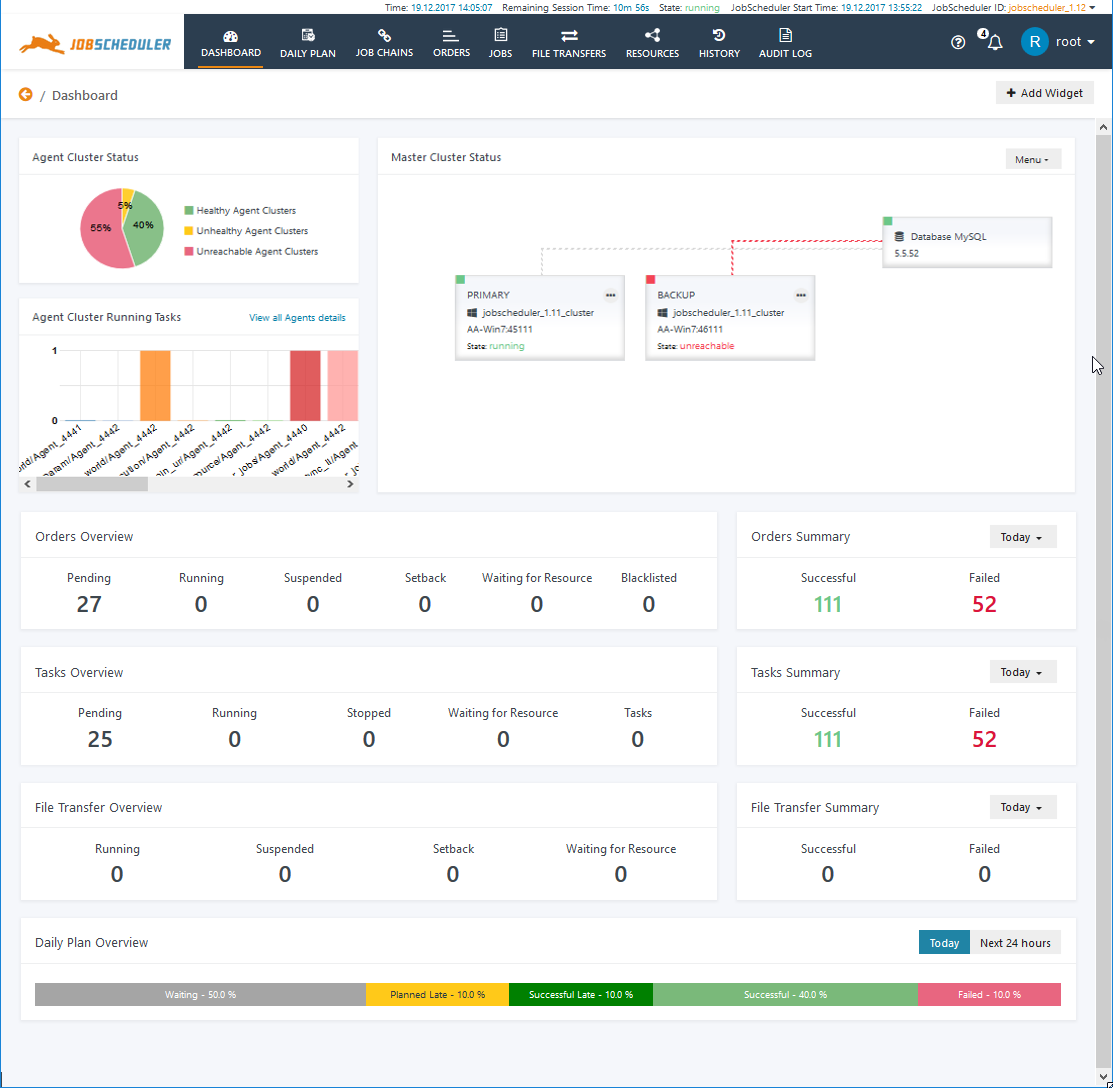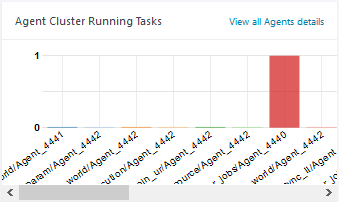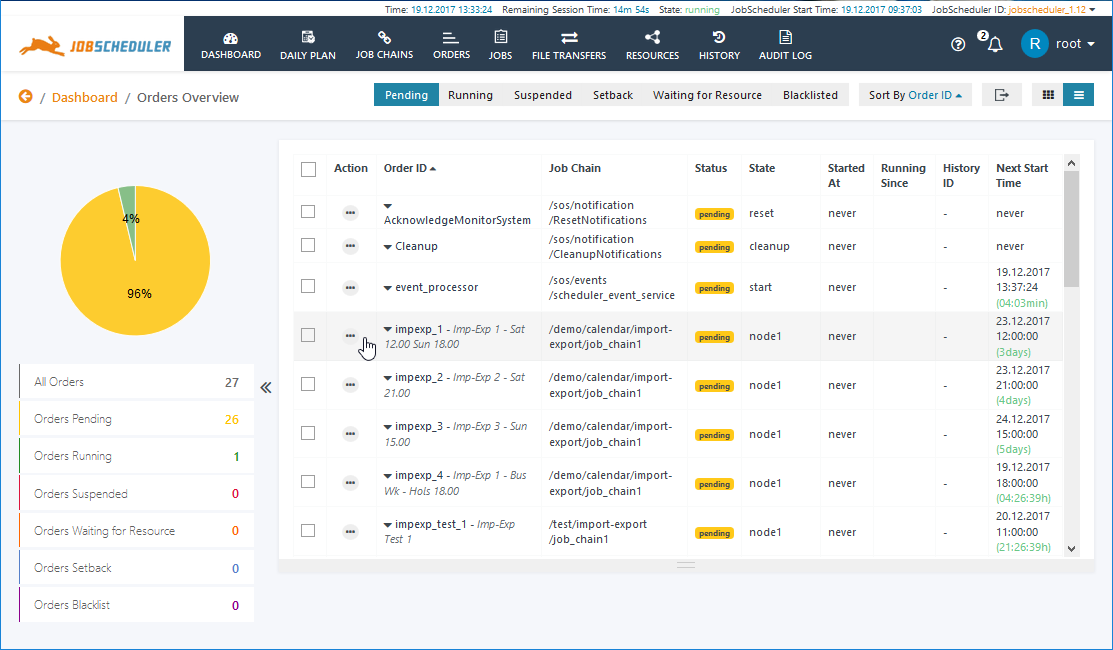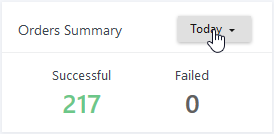Introduction
The JOC Cockpit Dashboard is the default view that is opened after a user logs onto the JOC Cockpit. It is an interface that provides users with an overview of the activities of their JobSchedulers as well as a starting point for accessing information and managing scheduling activities. In addition a number of functions can be executed directly from the Dashboard.The Dashboard View is made up of the standard JOC Cockpit header menus and the Dashboard itself, which in turn is made up from a number of widgets as shown in the following screenshot:
The screenshot shows the default setting, which is with all widgets visible as shown.
Flexible Layout
Widgets can be moved by drag & drop as well as hidden and re-added, providing users with the most convenient information overview for the tasks they have to carry out. Layout changes are centrally saved in the JobScheduler's reporting database as part of the user's individual profile and are therefore accessible regardless of the workstation currently being used. FEATURE AVAILABILITY STARTING FROM RELEASE 1.12
The Profile View includes a setting for the Dashboard Widget Layout that can be set to either use the Default Layout or a Custom Layout:
- The Default Layout does not allow changes to widgets.
- The Custom Layout allows to re-arrange, to add and to drop widgets.
Authorization & Permissions
Note that users will only be able to view and use individual widgets when they have been assigned Roles with the necessary Permissions. See the JOC Cockpit - Authentication and Authorization article for more information about Roles and Permissions.
The JOC Cockpit Header Menus
The JOC Cockpit header menus are the same for all views and provide the following functions:
- JobScheduler Master selection (in the top row at the right hand end).
- View selection (the left hand portion of the bar with the dark gray background).
- Access to the User Profile menu (the right hand end of the bar with the dark gray background).
The JOC Cockpit header menus are described in more detail in the JOC Cockpit - Navigation and Usability article.
The Dashboard View Widgets
The Dashboard View is made up of the following widgets:
Agent Cluster Status
This widget shows summary of the status of all the agent clusters known to the JobScheduler Master. Three statuses are possible:
Healthy - the agents or clusters that are running ok,
Unhealthy - only applies for a cluster - where one or more agents in the cluster are not working,
Unreachable - where an agent cluster is not responding.
- Clicking the links in the widget opens the Resources View with the Agent Clusters having the relevant status being shown.
Agent Cluster - Description
- An Agent Cluster is defined as the Agents specified in a Process Class. The availability of an Agent Cluster determines whether a Job or Order specified for that Cluster will be executed. The availability of Agent Clusters is therefore more important than, for example, the availability of individual Agents.
- The number of Agent Clusters may be larger or smaller than the number of individual Agents.
Agent Cluster Running Tasks
- The goal of this widget is to show at a glance the number of tasks that are currently running on each Agent Cluster.
- The View all Agents details link opens the JOC Cockpit Resources tab showing the Agent Clusters view with All Agent Clusters.
- The goal of this widget is to show at a glance the number of tasks that are currently running on each Agent Cluster.
Master Cluster Status
- This widget provides an overview of the operational status and health of a JobScheduler Master or JobScheduler Master Cluster.
It covers the range of JobScheduler architectures e.g. standalone, passive cluster, active cluster etc.
- The widget provides basic information - architecture, distribution, etc. - about a JobScheduler or Cluster on mouse-over.
- The Menu select box at the top right is only shown for a JobScheduler Master Cluster - and not for a stand-alone JobScheduler Master. It allows a number of operations to be carried out on the JobSchedulers in the Cluster, with the exception of a Supervisor JobScheduler, if any. The functions available include Restarting the whole cluster, Terminating Immediately, etc. The exact meaning of these controls for, for example, a Passive or Backup Cluster can be found in the Backup JobSchedulers Reference documentation. Note that:
- this menu will be empty if the primary JobScheduler Master is unreachable,
- a function to start an unreachable primary JobScheduler Master is not provided here and has to be carried out outwith the JOC Cockpit.
- Controls are also available for pausing, restarting, terminating and aborting individual JobSchedulers. These controls are available for standalone JobSchedulers or cluster members and are accessed using the Additional Options (ellipsis) icon.
Orders Overview
- This widget show a current overview of the individual states (e.g. running, setback, suspended, etc.) of the Orders being processed by the selected JobScheduler or JobScheduler Cluster.
- The information provided in this widget is updated in near real-time. The numbers shown in the widget are provided with links to the Dashboard Orders Overview Page which will then show those Orders with the state in question.
- The Dashboard Orders Overview Page provides a more detailed overview about the Orders being run by a particular JobScheduler Master or Master Cluster. Filter menus are provided to allow only Orders with a particular state to be shown.
Orders Summary
- This widget shows a summary of the orders that have been processed and the results they returned, e.g. successful or failed.
- The drop-down menu shown in the screenshot allows selection of the time period.
- Clicking on the numbers of Successful and Failed orders shown provides direct links to the History View, with the number of Orders run by the current Job Scheduler master and that were either successful or had failed in the last 12 hours being shown by default.
Tasks Overview & Tasks Summary
As with the Orders Overview and Orders Summary widgets described above these widgets are intended to provide users with a quick overview of how the Daily Plan is progressing. These widgets provide a near real-time information about Jobs and Tasks that have run. Both standalone and order jobs are included in the information shown in the widgets.
FEATURE AVAILABILITY STARTING FROM RELEASE 1.11.5- The links in the Jobs Overview widget lead to the Dashboard / Jobs Overview Page and the links in the Tasks Summary lead to the History page with the tasks that have been run by the current Job Scheduler master in the last 12 hours being shown by default.
File Transfer Overview & File Transfer Summary
These two widgets provide an overview of the File Transfer History, which can be accessed in full in the File Transfers view. The information displayed in both widgets is updated in near real-time. FEATURE AVAILABILITY STARTING FROM RELEASE 1.11.5
The links in both widgets lead to the File Transfers view with the view being configured according to the link in the widget that was clicked.
Daily Plan Overview
The goal of this widget is to give users a quick overview of how the Daily Plan is progressing.
The widget can show an overview for the current day or for the next 24 hours.
- Clicking on the text links in the widget opens the Daily Plan view showing the orders for the time period and result specified.









